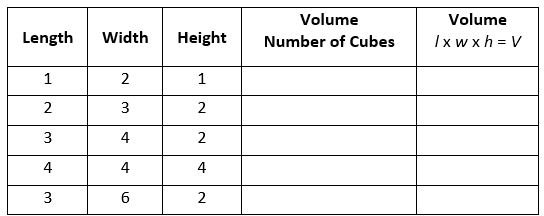Determining Volume With Formulas: Math Lesson Plan for Grade 5
Lessons 1, 2, and 3 of this series investigated the concept of volume of a rectangular figure by counting the number of cubes packed into the container. In this lesson, students will apply the formulas V = l x w x h and V = b x h to find volumes of right rectangular prisms with whole-number edge lengths in the context of solving real world and mathematical problems.
Lesson Objective: The lesson is aligned to the Common Core State Standards for Mathematics – 5MD.5b Geometric Measurement – Apply the formulas V = l x w x h and V = b x h for rectangular prisms to find volumes of right rectangular prisms with whole-number edge lengths in the context of solving real world and mathematical problems.
Materials Required: unit cubes, sugar cubes, blocks, calculator
Lesson Procedure
Use your unit cubes, sugar cubes, or blocks to build the rectangular figures with the measurements shown in the chart above. Complete the chart.
Now, use your unit cubes, sugar cubes, or blocks to build the rectangular figures with the measurements shown in the chart above. Complete the chart.
Answers
Individual or Group Work
1. Emily has a stack of books. The length of each book is 22 centimeters and the width of each book is 17 centimeters. The height of the stack of books is 12 centimeters. Emily wants to store the books in a box. What is the volume of a box Emily will need? Show how you found your answer.
2. Jasper has a carton. The length of the carton is 3 feet, the width is 4 feet, and the height is 5 feet. What is the volume of the carton?
3. Reese has 2 containers. The area of the base of one container is 15 square inches and the height is 4 inches. The other container has a length of 6 inches, a width of 2 inches, and a height of 5 inches. Do the containers have equal volume? Show how you found your answer.
4. Jack has 12 blocks. The length of each block is 2 inches, the width is 3 inches, the height is 1 inch. Jack has a box that has a volume of 60 cubic inches. Can Jack store all 12 blocks in the box? Show how you found your answer.
Answers:
- 22 x 17 x 12 = 4,488 cubic centimeters
- 3 x 4 x 5 = 60 cubic feet or 3 x 4 = 12, 12 x 5 = 60 cubic feet
- Yes, 15 x 4 = 60 cubic inches and 6 x 2 x 5 = 60 cubic inches
- No, each block has a volume of 2 x 3 x 1 = 6 cubic inches. To hold 12 blocks, the box would need to have a volume of 72 cubic inches
Students should be able to apply the formulas V = l x w x h and V = b x h to find volumes of rectangular prisms.
Download a copy of this lesson plan.
This post is part of the series: Finding Volume Measurement With Unit Cubes
This collection of fifth grade lesson plans focuses on teaching the concept of the unit cube and how it can be used to develop volume measurement formulas. All lessons meet Common Core objectives.
